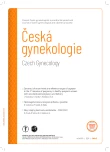Interprofessional cooperation with a dermatovenerologist – specifics of hidradenitis suppurativa management in gynaecological practice
Authors:
B. Ivanková 1
; T. Kampe 1; J. Baloghová 1,2
Authors‘ workplace:
Klinika dermatovenerológie UN L. Pasteura, Košice, Slovenská republika
1; Lekárska fakulta, Univerzita P. J. Šafárika, Košice, Slovenská republika
2
Published in:
Ceska Gynekol 2024; 89(2): 114-119
Category:
doi:
https://doi.org/10.48095/cccg2024114
Overview
Hidradenitis suppurativa is a chronic immune-mediated inflammatory disease that is manifested by formation of painful nodules, abscesses and suppurating fistulas, primarily in the intertriginous spaces. This painful, often under-diagnosed disease affects much more women. They are also exposed to certain specific challenges in the management of this disease, especially during menstruation or pregnancy. The treatment requires the interdisciplinary cooperation of a dermatologist, gynaecologist, obstetrician and last but not least an algesiologist and psychotherapist. Above all, early and correct diagnosis, initiation of therapy in the early stages of the disease, is a key, which also plays a fundamental role in controlling inflammatory activity, preventing complications and further prognosis.
Keywords:
early diagnosis – comprehensive management – autoimmune inflammation – Hidradenitis suppurativa – specifics in the female population
Sources
1. Péčová K. Hidradenitis suppurativa – biologická liečba. Dermatol Prax 2016; 10 (4): 126–129.
2. van der Zee HH, de Ruiter L, van den Broecke DG et al. Elevated levels of tumor necrosis factor alfa, interleukin 1 beta in hidradenitis suppurativa skin: a rationale for targeting TNF alfa and IL beta. Br J Dermatol 2011; 164 (6): 1292–1298. doi: 10.1111/j.1365-2133.2011.10254.x.
3. Prens E, Deckers I. Pathophysiology of hidradenitis suppurativa: an update. J Am Acad Dermatol 2015; 73 (5 Suppl 1): S8–S11. Doi: 10.1016/ j.jaad.2015.07.045.
4. Revuz JE, Canoui-Poitrine F, Wolkenstein P et al. Prevalence and factors associated with hidradenitis suppurativa: results from two case-control studies. J Am Acad Dermatol 2008; 59 (4): 596–601. doi: 10.1016/j.jaad.2008.06.020.
5. Vorčáková K, Péčová K, Madleňák M et al. Hidradenitis suppurativa – terapeutická výzva pre dermatológa. Dermatol Prax 2021; 15 (2): 62–67.
6. Garag A, Neuren E, Strunk A. Hidradenitis suppurativa is associated with polycystic ovary syndrome: a population-based analysis in the United States. J Invest Dermatol 2018; 138 (6): 1288–1292. doi: 10.1016/j.jid.2018.01.009.
7. Kimball AB, Jemec GB, Yang M et al. Assessing the validity, responsiveness and meaningfulness of the Hidradenitis suppurativa Clinical Response (HiSCR) as the clinical endpoint for hidradenitis suppurativa treatement. Br J Dermatol 2014; 171: 1434–1442. doi: 10.1111/bjd.13270.
8. Stormo AR, Saraiya M, Hing E et al. Women‘s clinical preventive services in the United States: who is doing what? JAMA Intern Med 2014; 174 (9): 1512–1514. doi: 10.1001/jama- internmed.2014.3003.
9. Sevray M, Dupré PF, LeFlahec G et al. Vulvar squamous cell carcinoma complicating hidradenitis suppurativa in a young woman. JAAD Case Rep 2019; 5 (11): 999–1001. doi: 10.1016/j.jdcr.2019.08.025.
10. Zelenayová Z. Nemelanómové nádory kože. Dermatol Prax 2023; 17 (2): 57–65.
11. Cohen-Kurzrock R, Riahi R. Cutaneous metastatic breast cancer masked by hidradenitis suppurativa. Cureus 2021; 13 (1): e12862. doi: 10.7759/cureus.12862.
12. Collier KE, Parvataneni KR, Lowes AM et al. Diagnosis and management of hidradenitis suppurativa in women. Am J Obstet Gynecol 2021; 223 (1): 54–61. doi: 10.1016/j.ajog.2020. 09.036.
13. Ivanková, B. Základné komunikačné princípy lekár-pacient v ambulantnej praxi. Dermatol Prax 2022; 16 (2): 71–74.
14. Urbanček S, Vorčáková K. Aktuálna farmakoterapia hidradenitis suppurativa. Dermatol Prax 2022; 16 (1): 14–16.
15. Zouboulis CC, Desai N, Emtestam L et al. European S1 guideline for the treatment of hidradenitis suppurativa/acne inversa. J Eur Acad Dermatol Venereol 2015; 29 (4): 619–644. doi: 10.1111/jdv.12966.
ORCID autorov
B. Ivanková 0009-0005-6036-9357
J. Baloghová 0000-0003-4470-5777
Doručené/Submitted: 17. 9. 2023
Prijaté/Accepted: 18. 9. 2023
MUDr. Barbara Ivanková, MBA
Klinika dermatovenerológie
UN L. Pasteura
Tr. SNP 1
040 01 Košice
Slovenská republika
barbara.ivankova@unlp.sk
Labels
Paediatric gynaecology Gynaecology and obstetrics Reproduction medicineArticle was published in
Czech Gynaecology

2024 Issue 2
Most read in this issue
- New staging of endometrial carcinoma – FIGO 2023
- Trophoblast stem cells, trophoblast invasion, and organoids – advancements in gynecology
- Haemorrhagic stroke in pregnancy
- Dynamics of serum levels and reference ranges of copeptin in the 3rd trimester of pregnancy in healthy pregnant women with uncomplicated pregnancy and delivery
